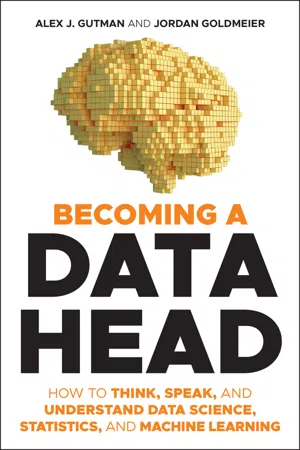
Becoming a Data Head
How to Think, Speak, and Understand Data Science, Statistics, and Machine Learning
- English
- ePUB (mobile friendly)
- Available on iOS & Android
Becoming a Data Head
How to Think, Speak, and Understand Data Science, Statistics, and Machine Learning
About this book
"Turn yourself into a Data Head. You'll become a more valuable employee and make your organization more successful."
Thomas H. Davenport, Research Fellow, Author of Competing on Analytics, Big Data @ Work, and The AI Advantage
You've heard the hype around data - now get the facts.
In Becoming a Data Head: How to Think, Speak, and Understand Data Science, Statistics, and Machine Learning, award-winning data scientists Alex Gutman and Jordan Goldmeier pull back the curtain on data science and give you the language and tools necessary to talk and think critically about it.
You'll learn how to:
- Think statistically and understand the role variation plays in your life and decision making
- Speak intelligently and ask the right questions about the statistics and results you encounter in the workplace
- Understand what's really going on with machine learning, text analytics, deep learning, and artificial intelligence
- Avoid common pitfalls when working with and interpreting data
Becoming a Data Head is a complete guide for data science in the workplace: covering everything from the personalities you'll work with to the math behind the algorithms. The authors have spent years in data trenches and sought to create a fun, approachable, andeminently readable book. Anyone can become a Data Head—an active participant in data science, statistics, and machine learning. Whether you're a business professional, engineer, executive, or aspiring data scientist, this book is for you.
Frequently asked questions
- Essential is ideal for learners and professionals who enjoy exploring a wide range of subjects. Access the Essential Library with 800,000+ trusted titles and best-sellers across business, personal growth, and the humanities. Includes unlimited reading time and Standard Read Aloud voice.
- Complete: Perfect for advanced learners and researchers needing full, unrestricted access. Unlock 1.4M+ books across hundreds of subjects, including academic and specialized titles. The Complete Plan also includes advanced features like Premium Read Aloud and Research Assistant.
Please note we cannot support devices running on iOS 13 and Android 7 or earlier. Learn more about using the app.
Information
PART I
Thinking Like a Data Head
- Chapter 1: What Is the Problem?
- Chapter 2: What Is Data?
- Chapter 3: Prepare to Think Statistically
CHAPTER 1
What Is the Problem?
“A problem well stated is a problem half solved.”—Charles Kettering, inventor & engineer
QUESTIONS A DATA HEAD SHOULD ASK
- Why is this problem important?
- Who does this problem affect?
- What if we don't have the right data?
- When is the project over?
- What if we don't like the results?
Why Is This Problem Important?
- What keeps you (us) up at night?
- Why does this matter?
- Is this a new problem, or has it been solved already?
- What is the size of the prize? (What's the return on investment?)
- Methodology focus: In this trope, companies simply think trying some new analysis method or technology will set them apart. You've heard this marketing fluff before: “If you're not using Artificial Intelligence (AI), you're already behind … .” Or, companies find some other buzzword they would like to incorporate (e.g., “sentiment analysis”).
- Deliverable focus: Some projects go off track because companies focus too much on what the deliverable will be. They say the project needs to have an interactive dashboard, for example. You start the project, but the outcome becomes about the installation of the new dashboard or business intelligence system. Project teams need to take a step back and trace how what they want to build brings value to the organization.
Table of contents
- Cover
- Table of Contents
- Title Page
- Copyright
- Dedication
- About the Authors
- About the Technical Editors
- Acknowledgments
- Foreword
- Introduction
- PART I: Thinking Like a Data Head
- PART II: Speaking Like a Data Head
- PART III: Understanding the Data Scientist's Toolbox
- PART IV: Ensuring Success
- Index
- End User License Agreement